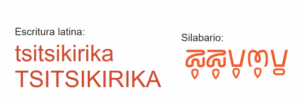“I have always been passionate about history, people and ancestral knowledge. This initiative was born in 2016, since I had direct contact with these native tongues. Over the last year and a half I made a team with Dr. Carlos Duche, an anthropologist, and Dr. Olivier Meric, a sociolinguist, and the enthusiastic American project manager Kayla Vandevort BA and also the warm consulting of beautiful native speaker people.
“I am a type designer, and for the last two years I have been designing and programming a font in opentype. It is normally written with the letters of a normal keyboard. You just have to activate Opentype, contextual, discretionary, decorative ligatures. In a very similar way to abugidas like Hindi. Even while they are activated depending on the context and for the language you are using.
“This system presents a holistic principle of construction, with bilateral symmetry, glyphs of mostly a single stroke and the syllables take anthropomorphic zoo forms very similar to the worldview of the peoples, crafts even petroglyphs of our native peoples.
“This writing system is designed for most of the 14 indigenous tongues of Ecuador. I focused especially on the Sapara tongue, which is in danger of extinction and was declared an Intangible Heritage by UNESCO, the Wao Tededo tongue, which only has 16 phonemes, Kichwa, which is the most widely spoken indigenous language in the country, and a little of Shuar. I will gradually add more syllables from the other tongues.
“Ecuador is a plurinational country, and each indigenous nationality has a certain autonomy in political and educational terms. All indigenous tongues in Ecuador are written with the Latin alphabet, and with the exception of Kichwa, each indigenous nation has a certain autonomy to regulate their language, grammar and writing with the coordination of the Ministry of Education.
“Over time I understood that the problem itself is not the Latin alphabet, but the colonial consequences that the Spanish language (and its Latin alphabet) had on the way of writing, synthesizing and assimilating the original tongues for their native speakers. Also educational problems consequences of an unequal distribution of the profits from oil exploitation in the Amazon, which for the most part has only impoverished indigenous communities.
“I usually show the benefits of the syllabary with the word tsitsikirika (woodpecker ) in Sapara, since with this writing system its assimilation is much more practical since many tongues have digraphs like ng, ts; that are not present in Spanish.

“Additionally I contemplate the idea of virtual keyboard packages for Gboard in Latin alphabet. (We could start with Kichwa.) This will be a very useful tool, since the Gboard is the first thing that appears on the smartphone, and always native speakers must write in their language with the setup in Spanish.
“In the end, my position and that of my team is decolonizing. We do not want to impose anything on anyone, nor repeat colonial schemes. The Latin system can remain standard, but I am sure at least in theory that this method allows a better understanding of indigenous languages.
“With respect to the use of the Amazonian Syllabus by indigenous peoples, time and the relationship with the communities will define how practical this system is for each language and whether the people assimilate it or not.
“I understand that these processes take a long time. I have direct communication with indigenous organizations and the methodology would be to go native nation to native nation, whose academics and native speakers are excited about the project.As you will know here the indigenous peoples are very active politically and have been a bit busy in their processes of social struggle. In particular the Sapara people have been very open with me: they have provided me with books and I have their permission to continue investigating, and very soon I will officially approach the Waodani people.
“We are just about to publish a paper or publication with the Universidad Estatal Amazonica. The endorsement of international projects/institutions can give enhancement and prestige to Silabario Amazonico.
“I am very sure that being able to have a space in Unicode can allow expanding research even with the help of other independent researchers, especially for Kichwa, which is a variant of Quechua spoken in Peru and Bolivia and to some extent in Colombia and Chile. In addition, the project of Gboards for indigenous tongues, especially those that are in danger like Sapara, can help a lot to safeguard it, and bring proud joy and welfare for native peoples.”
1.8312° S, 78.1834° W